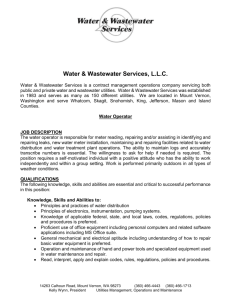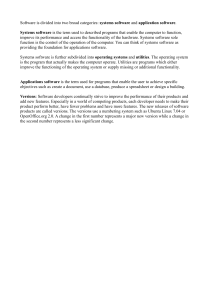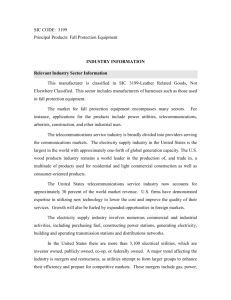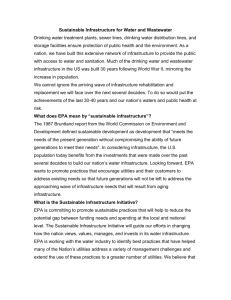PPT - Mid-America Regulatory Conference
advertisement
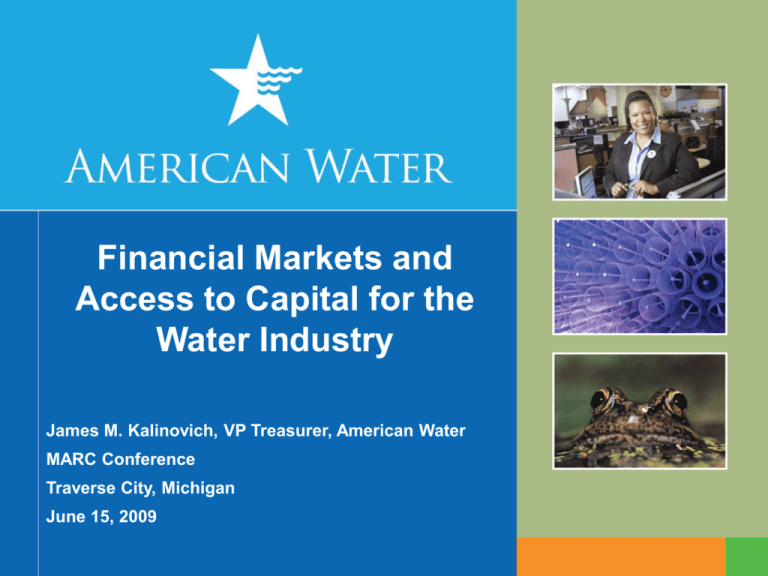
Financial Markets and Access to Capital for the Water Industry James M. Kalinovich, VP Treasurer, American Water MARC Conference Traverse City, Michigan June 15, 2009 American Water’s Regulated Presence Ontario WA MT ME ND OR VT MN ID NH SD NY WI WY MI NE NV PA IA IL UT CO CA KS IN OH MD WV MO VA MA CT RI NJ DE Washington DC KY AZ OK NM AR SC AL GA LA Hawaii AK 2008 Revenues ($ in millions) NC TN MS TX State Customers Served FL New Jersey 643,330 $517.7 Pennsylvania 648,958 447.9 Illinois 307,734 187.5 Missouri 456,887 181.1 Indiana 283,886 156.4 California 170,853 128.6 West Virginia 170,404 115.7 Other 639,663 347.8 3,321,715 $2,082.7 Total Regulated Business American Water serves approximately 5% of the U.S. population 2 Facts & Figures (owned Assets) • 372 individual service areas • 46,000 miles of distribution mains • 80 surface water treatment plants • 600 groundwater treatment plants • 1,000 groundwater wells • 45 wastewater treatment plants 3 Background • Current financial and credit crises are causing severe challenges and dislocations throughout virtually every sector of the economy, but . . . No sector is more important to public health and welfare than high quality drinking water and sanitation services: Water is ingested and essential to life Critical infrastructure, such as energy, health care, fire fighting, disaster recovery, etc depend on water Effective wastewater management is critical to health and environmental quality Access to and cost of capital affected 4 Economic Crises’ Impact on AWK • Increases in cost of debt • Market volatility hampers new equity issuance and raises implied costs of equity • Potential effects on Capex program • Depressed housing sector hurts customer growth • Increase in bad debt expense • Credit Markets’ performance negatively impacts retirement plans assets, thus increasing the Pension and Other Post Retirement Benefits Costs and Cash Contributions 5 Market Volatility still remains and is main factor for increased cost of capital CBOE S&P Volatility Index LTM TED Spread The VIX Index represents the market’s expectation of volatility of the S&P 500 over the next 30 day period 90 The TED spread is the difference between the 3 month T bill and the 3 month LIBOR and is an indicator of perceived risk in the economy 5 75 4 60 3 45 2 30 1 15 0 4/29 5/29 6/28 7/28 8/27 9/26 10/26 11/25 12/25 1/24 2/23 3/25 During the month of April the VIX continued a sideways trading pattern, lower than October 2008 highs but still 50% higher than before onslaught of credit crisis in November 2008 4/24 0 4/29 5/29 6/28 7/28 8/27 9/26 10/26 11/25 12/25 1/24 2/23 3/25 4/24 TED spreads continue to show lower perceived market risk, as spreads to LIBOR have remained steady at around 100 basis points. TED spreads averaged 15 basis points from 2000-2005 6 Weighted Average Cost of Debt: By Subsidiary 10.50% 9.00% 7.50% Current New Debt Issuance Rates: 6.5% to 8.5% 6.00% 4.50% W V VA TX TN PA O H M N J N M I M O M D LI Y K IN Il IA I H A C Z A A W CC A W E A W K 3.00% Interest Rates 7 Spreads: 30 Year US Treasury Notes and “A” & “BBB+” Utilities 500 450 400 350 300 250 200 150 100 50 0 Dec-07 Jun-08 Sep 2008 Oct-08 Nov-08 Dec-08 BBB+ Utilities Jan-09 Feb-09 Mar-09 Apr-09 A Utilities Source: Spread History for “A” and “BBB+” Utilities on Bloomberg 8 Challenges: • Capital Attraction Drinking Water: $334.8 Billion/20 years February 2009 USEPA Drinking Water Infrastructure Needs Survey (2002 Estimate: $154 Billion) Clean Water: $331-450 Billion/20 years 2002 USEPA GAP Analysis 20 Year Water/Wastewater Need: Approximately $1 Trillion • Fragmentation 53,000 Community Water Systems 3,200 Electric; 2,700 Gas • Expanding Water Quality Requirements 98 Inorganic, Organic, Microbiological, Disinfection by Products, Radionuclides More Coming 9 No Utility Sector is More Capital Intensive Than the Water Industry 2007 Capital Intensity $4.00 $3.50 $3.35 $3.00 $2.50 $1.67 $2.00 $1.31 $1.50 $1.17 $1.13 $0.33 $0.88 $1.00 $0.50 $0.00 Water Electric Comb E&G Gas Dist. Tel Cos Avg All Ind. S&P 500 Source: AUS Utility Reports – 2008 10 Enhanced Importance of Policies that Promote Capital Attraction • Reduction of Regulatory Lag Prospectively relevant test years Infrastructure replacement surcharges • Promotion of Consolidation Economies of scale Viability Single tariff pricing 11 CAPITAL ATTRACTION: Timely Recovery of Invested Capital – Regulatory Lag Historic Test Year Jan ’03 Jan ‘ 04 Jan 1 ‘05 Jan 1 ‘06 Mar ’04 Rate Case Filed June ’04 Investment New Rates Effective Test Year Loss of Return & Depreciation Investment Mitigation: Prospectively relevant test years: •Future test years (eg, IL, KY, TN, NY) •Step Increase (eg, CA – 3-year rate cycle) •DSIC (IL, PA, DE, MO, IN, NY, OH, CT) Sept ’05 Investment Jan 1 ’08 Jan 1 ‘07 Mar ’07 New Rate Case File New Rates Effective Assuming a nine month rate proceeding and a goal to stay out of a rate case for two years: The utility will earn no return of or on an investment made in June ’04 for 3 ½ years Results: • Dilutes allowed returns • Skews efficient capital invested • Forces more frequent rate cases 12 Negative Impact of Regulatory Lag and Potential Impact on Cost of Capital for Capital Intensive Regulated Industries “Primarily because of regulatory lag and increased financing expenses that cause balance sheet strain and execution risks, utilities suffer sub par returns during periods of heavy capital investment.” (Source: Lehman Brothers; Power and Utilities: Regulated Utilities; Global Equity Research, North America, May 22, 2007) Infrastructure Replacement Surcharge Programs Permit Utilities to Better Manage Cash Flows and Capitol Programs in Times of Extreme Financial /Market Volatility “Firms can also reallocate capital to projects with more timely return periods and take advantage of regulatory mechanisms that recover investment more quickly. Pennsylvania’s distribution system infrastructure charge (DSIC), which allows a monthly customer surcharge for pipe repair costs, is an example of this.” (Source: Janney Montgomery Scott, LLC; Water Industry Report; October 30, 2008) 13 Perception of Regulatory Support (Maintenance of “Regulatory Compact”) Essential to Continued Access to Capital for Water Utilities 120% 110% 100% 90% 80% 70% 60% 50% AWK DJIA S&P 500 4/ 29 4/ 17 4/ 5 3/ 24 3/ 12 2/ 28 2/ 16 2/ 4 1/ 23 1/ 11 12 /1 8 12 /3 0 12 /6 10 /7 10 /1 9 10 /3 1 11 /1 2 11 /2 4 9/ 25 9/ 13 9/ 1 8/ 20 8/ 8 7/ 27 7/ 15 7/ 3 6/ 21 6/ 9 5/ 28 5/ 4 5/ 16 4/ 22 40% Water - Peers Price as a percent of base (April 23, 2008 = 100%) Water Peers: WTR CWT AWR SJW SWWC MSEX CTWS YORW 14 NAWC Infrastructure Initiatives • Investment Tax Credits • Public Utility Dividend Reinvestment Plans • Tax Exempt Financing • Depreciation/Bonus Depreciation • State Revolving Loan Funds 15 Status of Stimulus Package Tax Incentives Some success on each of the following: • Bonus Depreciation Provision Extension • Alternative Minimum Tax (AMT) Exemption on Tax Exempt Bonds • State Revolving Loan Funds (SRF) 16
